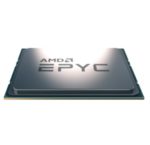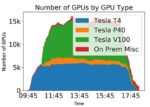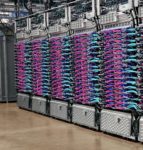Schrödinger has entered into a three-year agreement with Google Cloud to substantially increase the speed and capacity of its physics-based computational platform for drug discovery. “We’re excited to harness Google Cloud’s highly scalable system to run extensive free energy calculations to assess binding affinities through our compute-intensive FEP+ application. This partnership also enables us to further leverage BigQuery to analyze important molecular properties nearly instantaneously,” said Shane Brauner, Schrödinger’s Chief Information Officer. “This partnership is expected to allow us to expand the use of our physics-based computational platform to continue to rapidly explore very large swaths of chemical space.”
AMD EPYC Cloud Adoption Grows with Google Cloud
Today Google Cloud announced the beta availability of N2D VMs on Google Compute Engine powered by 2nd Gen AMD EPYC processors. The N2D family of VMs is a great option for customers running general purpose and high-performance workloads requiring a balance of compute and memory. “AMD and Google have worked together closely on these initial VMs to help ensure Google Cloud customers have a high-performance and cost-effective experience across a variety of workloads, and we will continue to work together to provide that experience this year and beyond.”
Second GPU Cloudburst Experiment Paves the Way for Large-scale Cloud Computing
Researchers at SDSC and the Wisconsin IceCube Particle Astrophysics Center have successfully completed a second computational experiment using thousands of GPUs across Amazon Web Services, Microsoft Azure, and the Google Cloud Platform. “We drew several key conclusions from this second demonstration,” said SDSC’s Sfiligoi. “We showed that the cloudburst run can actually be sustained during an entire workday instead of just one or two hours, and have moreover measured the cost of using only the two most cost-effective cloud instances for each cloud provider.”
Video: Atos Partners with Google Cloud for HPC
Today Atos announced that the Google Cloud has selected the company as an HPC services partner, expanding the global partnership with new services for enterprise customers. “Leveraging the skilled workforce, speed and scale of the CEPP from Atos, customers’ workload management will be supported by key analysis and optimization for their application performance on Google Cloud.”
Google Cloud TPU Pods Speed Machine Learning
Today Google announced that its Google Cloud TPU Pods are now publicly available in beta. Designed to help Machine Learning researchers iterate faster and train more capable machine learning models, TPU Pods can include more than 1,000 individual TPU chips connected by an ultra-fast, two-dimensional toroidal mesh network.
Get Your Head in the Cloud: Lessons in GPU Computing with Schlumberger
Wyatt Gorman from Google and Abhishek Gupta from Schlumberger gave this talk at the GPU Technology Conference. “Demand for GPUs in High Performance Computing is only growing, and it is costly and difficult to keep pace in an entirely on-premise environment. We will hear from Schlumberger on why and how they are utilizing cloud-based GPU-enabled computing resources from Google Cloud to supply their users with the computing power they need, from exploration and modeling to visualization.”
Is Ubiquitous Cloud Bursting on the Horizon for Universities?
In this special guest feature from Scientific Computing World, Mahesh Pancholi from OCF writes a growing number of universities are taking advantage of public cloud infrastructures that are widely available from large companies like Amazon, Google and Microsoft. “Public cloud providers are surveying the market and partnering with companies, like OCF, for their pedigree in providing solutions to the UK Research Computing community. In order to help Universities take advantage of their products by integrating them with the existing infrastructure such as HPC clusters.”
SingularityPRO comes to Google Cloud
Today Sylabs announced a multi-phase collaboration with Google Cloud as a technology partner. Aimed at systematically addressing enterprise requirements in a cloud-native fashion, the first phase of the collaboration will be based upon availability of Sylabs’ SingularityPRO via the Google Cloud Platform Marketplace. “Singularity is a widely adopted container runtime that implements a unique security model to mitigate privilege escalation risks, and provides a platform to capture a complete application environment into a single file.”
Atos Opens AI Laboratory in France with the Google Cloud
Today Atos inaugurated a new AI laboratory in France. Set up as part of the global partnership between Atos and Google Cloud, the laboratory will enable clients, businesses and public organizations to identify practical cases, for which AI could provide innovative and effective solutions. “In order for France to continue to play a key role in the information space, it has to invest heavily in artificial intelligence and new technologies,” said Thierry Breton, Chairman and CEO of Atos. “Beyond economic development, being able to offer technological excellence while protecting European data is a matter of sovereignty. With this joint laboratory between Atos and Google Cloud, we are enabling the adoption of artificial intelligence by our clients by offering them the best technologies and the highest level of security for their data processing, all within a clearly defined European regulatory framework. As such, Atos combines economic and technological development with sovereignty, compliance and security and helps to design a secure and valued European information space.”
E-CAS Project to Explore Clouds for Acceleration of Science
Can the Cloud power ground-breaking research? A new NSF-funded research project aims to provide a deeper understanding of the use of cloud computing in accelerating scientific discoveries. “First announced in 2018, the Exploring Clouds for Acceleration of Science (E-CAS) project has now selected the six research proposals to explore how scientific workflows can leverage advancements in real-time analytics, artificial intelligence, machine learning, accelerated processing hardware, automation in deployment and scaling, and management of serverless applications for a wider range of science.”











